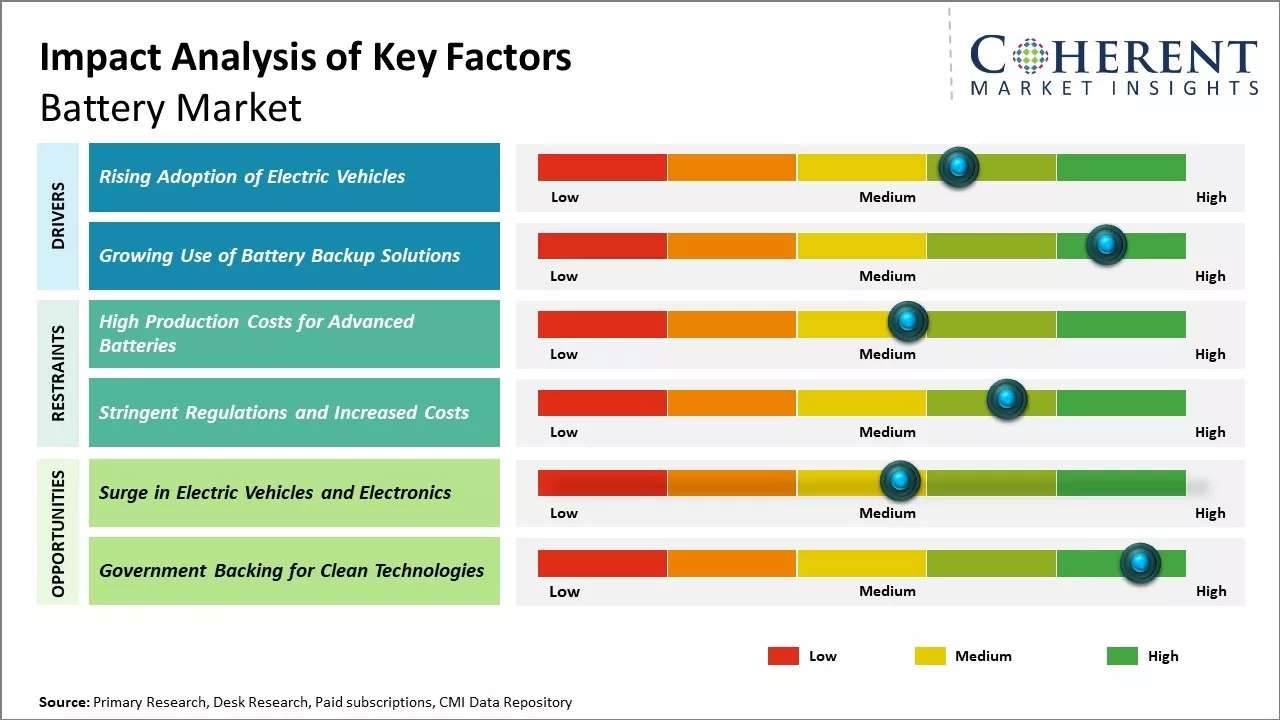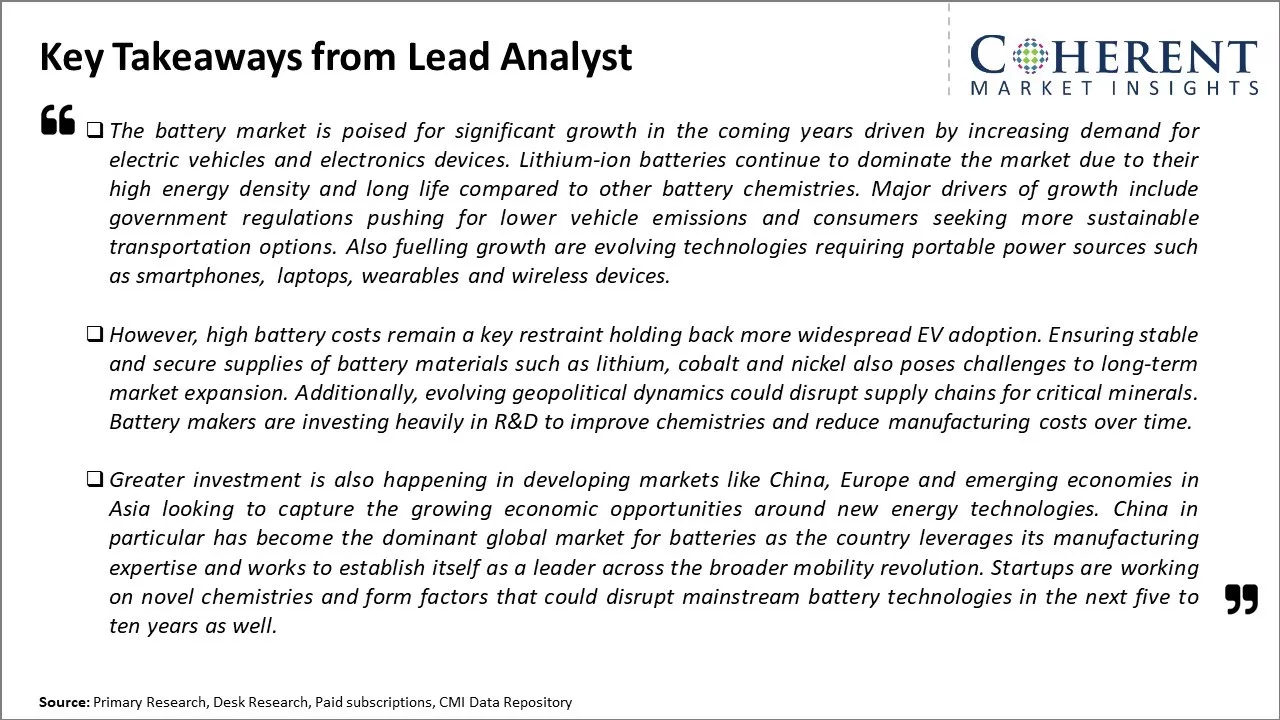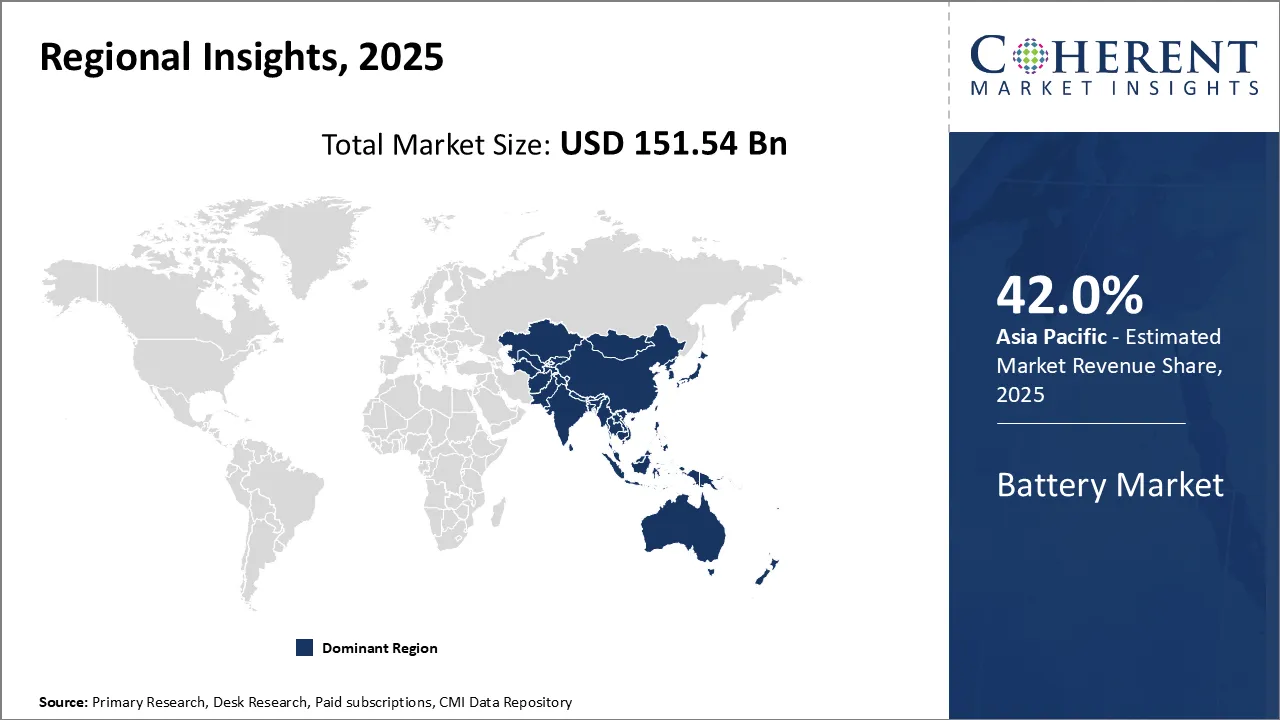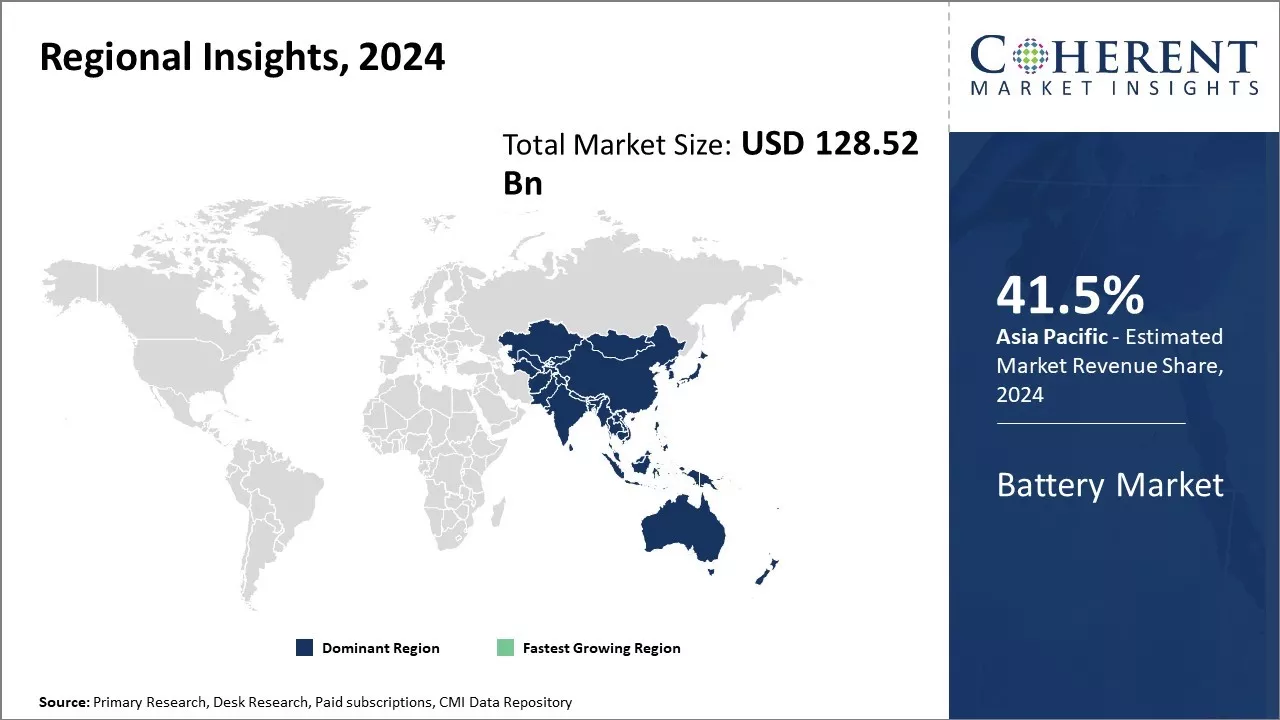Global battery market is estimated to be valued at US$ 151.54 billion in 2025 and is expected to reach US$ 480.15 billion by 2032, exhibiting a compound annual growth rate (CAGR) of 17.9% from 2025 to 2032.

Discover market dynamics shaping the industry: Request sample copy
Global battery market growth is driven by increasing demand for EVs and energy storage systems across the globe. Lithium-ion batteries continue to dominate the transportation and stationary storage applications due to their high energy density. Furthermore, decreasing prices of lithium-ion batteries makes EVs and energy storage more viable and affordable. Governments around the world are also supporting the shift to sustainable technologies by providing various incentives and subsidies for EVs and renewable energy projects. This increasing focus on reducing emissions is expected to boost demand for batteries over the next decade.
Rising Adoption of Electric Vehicles
Growing concern over environmental pollution and rising fuel costs have resulted in increased focus on developing more sustainable transportation solutions. Electric vehicles that run on advanced battery technologies are emerging as a viable alternative to fuel-based vehicles. Several automobile manufacturers have ramped up investments in electric vehicles in response to tightening emission norms and shifting consumer preferences towards green mobility options. Battery electric vehicles and plug-in hybrid electric vehicles provide comparable driving ranges to gasoline vehicles and allow consumers to refuel using electricity from the grid instead of gasoline. The upfront costs of EVs are compensated over time through lower fuel and maintenance expenses. Supportive government initiatives such as purchase incentives and investments in charging infrastructure are encouraging more consumers to make the switch to EVs. Major automakers are aggressively expanding their EV lineups with new models featuring longer driving ranges. This rising adoption of electric vehicles across passenger and commercial segments is anticipated to boost demand for advanced lithium-ion battery packs.
For instance, in September 2023, Gotion, a lithium-ion battery manufacturer, announced a US$ 2 billion investment in its inaugural factory in Manteno, Illinois, U.S. This facility, slated to become the largest EV battery production, will repurpose an existing Kmart distribution center and is projected to employ up to 2,600 workers. The plant will churn out 40 GWh lithium-ion battery cells and 10 GWh battery packs, focusing on energy storage system integration and supporting Illinois' climate change objectives. Gotion stands to gain significant state incentives and intends to erect a battery component factory in Michigan.

Get actionable strategies to beat competition: Request sample copy
Growing Use of Battery Backup SolutionsThe constant evolution of digital technologies and increasing usage of smart devices have heightened the importance of uninterrupted access to electricity. Power outages remain a persistent problem in many parts of the world, owing to aging electrical infrastructure, natural calamities and grid failure risks. To safeguard against unexpected disruptions in power supply, industrial facilities, telecom towers, data centers and buildings have been strengthening their dependency on battery backup reserves. Lithium-ion batteries are the technology of choice for such backup power applications due to their high energy density, long service life and relatively lower self-discharge rates compared to lead-acid alternatives. In remote and off-grid areas lacking access to centralized power networks, batteries play a vital role in energizing essential needs through micro-grid and solar-plus-storage solutions. The growing energy needs of a digitally connected world along with instability in conventional grids is propelling the battery storage industry. As reliance on backup power grows, there will be a corresponding rise in demand for advanced battery packs that can effectively deliver on reliability, performance and long-term cost viability.
For instance, in June 2020, Tesla announced plans to manufacture next-generation electric vehicle batteries, designed to eliminate the rare, costly, and controversial element cobalt from batteries. This breakthrough technology is poised to enable cars to travel 400 miles or more between charges.

To learn more about this report, Request sample copy
Market Challenges: High Production Costs for Advanced BatteriesBattery technology has seen slow progress in recent decades, with current lithium-ion batteries nearing their peak performance. The high cost of producing high-capacity, long-lasting batteries can hinder market expansion. Sourcing materials like lithium, cobalt, and graphite poses supply chain risks, especially with increasing demand. Strict regulations on battery shipment also raise costs. Additionally, consumer acceptance presents a challenge for new battery technologies due to uncertainties about performance, safety, and lifespan.
Market Opportunities: Surge in Electric Vehicles and Electronics
The rise of electric vehicles and electronics presents significant growth opportunities for the market. Battery demand is expected to surge over the next decade. Government backing for clean technologies is driving substantial research and development investments into innovative battery chemistries such as solid-state, lithium-sulfur, and lithium-air, which offer the potential to revolutionize performance.

Discover high revenue pocket segments and roadmap to it: Request sample copy
Insights, By Type - Convenience and reliability boosts adoption of primary batteryBy type, primary battery segment is estimated to contribute the highest market share of 67.6% in 2025, owing to its convenience and reliability characteristics. Primary batteries, also called disposable or single-use batteries, provide a portable and convenient power source for many common consumer devices. The simplicity of primary batteries makes them attractive for devices that only require intermittent power for things like remote controls, toys, flashlights, calculators and more. Not requiring recharging means these batteries can power devices immediately without extra charging steps. This on-demand usability is a driving factor in their widespread adoption.
Primary batteries also provide reliable energy even after long periods of non-use. Stored on a shelf for months or years, primary batteries can still power devices when needed due to their sealed and non-rechargeable design. This long shelf-life makes them well-suited for emergency use cases and applications requiring standby power.
Common primary battery chemistries like zinc-carbon and alkaline batteries are widely available at affordable prices, further supporting market growth. The low upfront battery investment compared to rechargeable options also appeals to price-sensitive consumers.
Insights, By Technology - Energy density and costs push Lithium-ion technology forward
By technology, lithium-ion battery segment is estimated to contribute the highest market share of 31.91% in 2025 due to its high energy density and falling production costs. Lithium-ion possesses several advantages over other rechargeable battery types, most notably a substantially higher energy density by volume and weight. This allows Lithium-ion to power devices for longer runtimes utilizing a smaller and lighter form factor.
The energy density benefits of Lithium-ion have made it the technology of choice for many consumer electronics and is enabling the electrification of other industries like automotive. As costs fall due to growing economies of scale in battery cell production, Lithium-ion is also becoming more cost competitive relative to its energy output versus older technologies. Lower costs are further driving adoption and range expansion into new applications.
Significant research and development across the supply chain is continually improving Lithium-ion battery performance. Advancements in chemistries, materials and manufacturing are translating to longer battery lifespan through more charge cycles. Improved safety standards are also bolstering Lithium-ion’s viability. Its leading energy storage capabilities combined with reduced costs and heightened safety will likely see Lithium-ion expand its market share dominance in the coming years.
Insights, By Application - Rise of electrified transportation boosts automotive batteries segment
By application, automotive batteries segment is estimated to contribute the highest market share of 38.62% in 2025, due to rising electric vehicle production and emerging mobility trends. Global commitments to reduce vehicle emissions and dependence on fossil fuels are accelerating the electrification of automotive powertrains. A growing variety of plug-in electric vehicles (EVs) like electric cars, hybrids and fuel cell vehicles require large, high-performance battery solutions.
Meanwhile, emerging micromobility solutions like electric scooters and bikes are utilizing smaller lithium-ion batteries for urban transportation alternatives. Battery-powered modes of individual transportation are on the rise to reduce urban congestion and pollution. This emergence of diverse electrified vehicles across small scooters to large trucks is fuelling exponential growth of automotive batteries segment.
Advancing battery technologies are critical to empowering sustainable automotive trends and revolutionizing personal transportation globally. This positions automotive batteries as the segment primed to grow most substantially in coming years from transportation sector transformation.

Need a Different Region or Segment? Customize now
Asia Pacific battery market has been witnessing strong growth over the past decade and currently dominates the global battery market with share of 42.0% in 2025. The region is also the fastest growing region with CAGR of 22.92% in 2025. The region is home to leading battery manufacturers and several top automotive brands. Strong focus on the automotive industry has propelled battery demand, especially for lithium-ion batteries which are frequently used in electric vehicles. Stringent emission regulations have pushed many automakers to increase electric vehicle production. This has significantly boosted the battery market as the batteries remain the key component of any electric vehicle. Additionally, demand from other applications such as consumer electronics and energy storage is also driving the battery market growth.
With developing economies such as China, India and ASEAN nations undergoing rapid urbanization and industrialization, the region is expected to be the fastest growing market for batteries globally. The presence of a sizeable consumer electronics industry with major hubs in China, Taiwan and South Korea has boosted the consumer battery market. China, in particular, has become an important exporter of lithium-ion battery cells and packs to the automotive industry worldwide. Several manufacturing plants are also being set up across Asia to augment production. Factors such as strong government support for the adoption of electric vehicles, favourable trade policies and availability of raw materials at competitive prices makes Asia highly attractive for battery manufacturing investments. Countries like China and South Korea already have a robust domestic battery market aimed at applications like consumer electronics, power tools and automotive uses.
Battery Market Report Coverage
| Report Coverage | Details | ||
|---|---|---|---|
| Base Year: | 2024 | Market Size in 2025: | USD 151.54 Bn |
| Historical Data for: | 2020 To 2024 | Forecast Period: | 2025 To 2032 |
| Forecast Period 2025 to 2032 CAGR: | 17.9% | 2032 Value Projection: | USD 480.15 Bn |
| Geographies covered: |
|
||
| Segments covered: |
|
||
| Companies covered: |
CATL (Contemporary Amperex Technology Co Ltd) , BYD Company Limited , Panasonic Corporation , LG Chem , Samsung SDI , SK Innovation , EVE Energy Co, Ltd , Tesla , AESC (Automotive Energy Supply Corporation), GS Yuasa Corporation , Coslight , Hitachi, Ltd , Johnson Controls International plc , Honeywell International Inc, Bosch Group , Varta AG , Pinnacle Electronics Inc, Microvast Holdings, Inc, Liontown Resources Limited , Freudenberg Group |
||
| Growth Drivers: |
|
||
| Restraints & Challenges: |
|
||
Uncover macros and micros vetted on 75+ parameters: Get instant access to report
Share
Share
About Author
As an accomplished Senior Consultant with 7+ years of experience, Pooja Tayade has a proven track record in devising and implementing data and strategy consulting across various industries. She specializes in market research, competitive analysis, primary insights, and market estimation. She excels in strategic advisory, delivering data-driven insights to help clients navigate market complexities, optimize entry strategies, and achieve sustainable growth.
Missing comfort of reading report in your local language? Find your preferred language :
Transform your Strategy with Exclusive Trending Reports :
Frequently Asked Questions
Joining thousands of companies around the world committed to making the Excellent Business Solutions.
View All Our Clients
US Reciprocal Tax Impact Analysis On Battery Market
Stay updated on tariff changes with expert insights and timely information